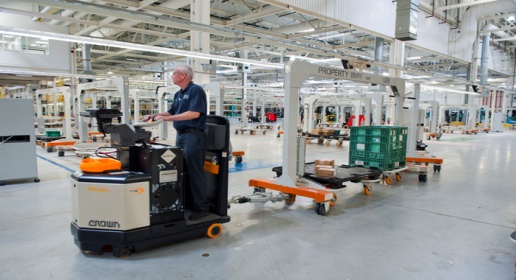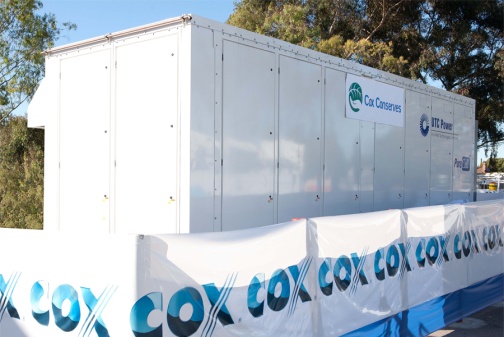Companies might be trying fuel cells to portray a green image, or to stay on the cutting edge of technology. They become repeat customers because the technology works and saves money over incumbent systems. As our reports show, there is a business case for fuel cells. With corporate, government, and international interest, fuel cell deployments are sure to grow even more over the next few years.
Elizabeth Delmont | Fuel Cells 2000
Fuel cells are steadily becoming a go-to technology for businesses interested in increasing both their economic and environmental bottom lines. Companies using fuel cells are saving money while reducing their carbon footprints and increasing their “green” profile. Although fuel cell products are just entering the market, early adopters are becoming repeat customers, with some companies purchasing systems from multiple manufacturers and for multiple applications. These repeat purchases are a positive sign that customers are pleased with fuel cells, and that the economics of owning a fuel cell makes business sense.
Fuel cells are gaining popularity in the corporate world due to their wide range of benefits. The electrochemical process that drives a fuel cell is inherently more efficient than combustion at turning fuel into energy, which is why fuel cells generate low to zero emissions, even from fossil fuel sources such as natural gas. Many businesses are beginning to make voluntary emission reduction targets such as Coca-Cola’s program to reduce absolute emissions by five percent by 2015 and fuel cells are helping them to reach this goal. Typical combustion processes release 25 pounds of pollution per 1,000 kWh of electricity produced; fuel cells release less than an ounce. In fact, fuel cell systems release so few emissions that the California Air Resources Board has made fuel cells exempt from air quality permitting requirements. Not having to apply for certain air quality permits can also save companies money and time. Fuel cells are a good investment because they emit near zero emissions, making them likely to meet any future regulations that may come.

Figure 1: UTC Power Fuel Cell at the 360 State Street Mixed Use Building Built By Becker + Becker
Fuel cells are also extremely quiet, reducing noise pollution. This can be especially important for businesses located in areas with strict noise ordinances. Noise can also be a factor for diesel-powered forklift operators and big-rig truck drivers. Eliminating this noise through the use of fuel cells can create better work conditions, and improve worker efficiency.
Another great benefit of fuel cells is their flexible siting and modular design. While solar panels can only be installed outside, and only in places where there is enough sunlight and space, fuel cells can be installed in or outdoors, near or away from buildings, and in hot or cold climates. Since fuel cells are modular they can be designed to fit almost any power need.
Fuel Cells 2000 has profiled more than 60 corporate customers using fuel cells. Our reports, The Business Case for Fuel Cells 2011: Energizing America’s Top Companies and The Business Case for Fuel Cells: Why Top Companies are Purchasing Fuel Cells Today 2010, explore how these companies are using fuel cells to help save money, electricity and fuel, and time, while increasing reliability and efficiency, improving public image, and reducing their carbon footprint at North American facilities. These customers, many Fortune 500 companies, are collectively saving millions of dollars in electricity costs while reducing carbon emissions by hundreds of thousands of metric tons per year. The profiled companies have installed, deployed or purchased more than 60 MW of stationary power, 2,000 fuel cell-powered forklifts and almost 1,000 fuel cells at telecommunications sites.
Grocery/Retail
Fuel cells are being used today to deliver highly efficient power to grocery and retail stores across the country. Fuel cells have electrical efficiencies between 40 and 60 percent which is more efficient than grid power, which is about 30 percent efficient. Chains such as Whole Foods Market and Price Chopper are using fuel cells at multiple locations. Whole Foods is even using fuel cell-powered forklifts at a distribution center in Maryland. Fuel cells can be used in combined heat-and-power (CHP) configurations, utilizing waste heat for hot water, space heating, even refrigeration and air conditioning. CHP systems can reach a combined efficiency of 85 percent or higher. Other stores taking advantage of CHP fuel cell systems include Stop & Shop, Albertsons, Star Market, and Safeway.

Figure 2: Plug Power Fuel Cell-Powered Material Handling Vehicles at BMW Plant
Reliability is another big selling point for fuel cells. According to Lawrence Berkeley National Laboratory, the annual cost of power interruptions in the U.S. is estimated at $80 billion or more.[1] Grocery stores are taking advantage of the reliability of fuel cells by designing systems that are grid parallel, meaning that systems may only provide a portion of the store’s total energy needs, but during grid outages critical functions are still powered independently by the fuel cell. During Hurricane Irene, which pummeled the East Coast in August 2011, the Whole Foods Market in Glastonbury, Connecticut, was able to keep its coolers running with its fuel cell. During a recent catastrophic power outage in Southern California, one of the only buildings in San Diego that retained power was the Albertsons grocery store, whose fuel cell is capable of operating independent of the grid - keeping the lights on and food fresh. For everyone else, the blackout lasted for 12 hours.
Fuel cells are also making an impression on large retailers. Walmart – the number 1 company on the Fortune 500 list - uses fuel cells to generate power at 17 of its California retail sites, as well as operating fuel cell-powered forklifts at several of its warehouses. These systems at Walmart add up to more than 6.8 MW of power.
Corporate Headquarters/Data Centers
In many cities, solar and wind power may not be an option due to lack of space and inadequate access to the elements - such as crowded urban settings where there isn’t enough square footage for a large-scale photovoltaic system. Fuel cells provide constant power and flexible siting, unlike other renewable options where output can vary. Adobe (profiled on p. 8 of the 2011 report), for example, took advantage of fuel cells’ smaller footprint and installed a 1.2-MW fuel cell system on the roof of the parking garage of their San Jose, California headquarters. In the beginning of February, Adobe announced the installation of an additional 400-kW of Bloom Energy Servers, bringing the total installation to 1.6 MW.[2]

Figure 3: Bloom Energy Servers on the Roof of Adobe Headquarters - Photo Credit, Edelman
Cox Enterprises is working hard to reduce company emissions by 20 percent by 2017. Fuel cells have become an important tool in helping the communications giant reach this goal. In 2010 Cox Enterprises installed a 400-kW fuel cell system from Bloom Energy at its TV station in Oakland, California, followed in 2011 by 1.6 MWs of UTC Power fuel cells installed at two facilities in San Diego and another facility in Orange County. Just a few weeks ago Cox announced yet another 500-kW installation of Bloom Energy Servers to power additional facilities in San Diego, bringing their total installed capacity from fuel cells to 2.5 MW.

Figure 4: UTC Power Unit at Cox Enterprises
Apple is also finding success with fuel cells. In 2011, the company installed a 500-kW biogas fuel cell to power facilities in Cupertino, California. Apple just announced plans to install a 5-MW installation at the Maiden, North Carolina data center. Once completed, this installation will be the largest non-utility owned fuel cell system in the United States.
Warehouse Operations
Fuel cell-powered forklifts have moved well past the demonstration stage to commercial sales and are providing customers with benefits on multiple fronts - savings in emissions, labor costs, and most importantly, time. Fuel cell forklifts last two to three times as long between fueling than batteries, with much shorter refueling times - one or two minutes compared to a half hour or longer to change out a battery. The Department of Energy’s analysis of the forklifts that have been funded and deployed via the American Recovery and Reinvestment Act concludes that fuel cells provide eight times lower refueling/recharging labor cost and two times lower net present value of total system cost compared to batteries.
Another significant benefit is elimination of storage space and battery changing rooms. Fuel cells have a significantly smaller footprint, which recovers valuable warehouse space to store more product. In Coca-Cola’s San Leandro, California, bottling and distribution facility, the company was able to recover more than 2,000 square feet of facility space by removing the infrastructure associated with the lead-acid battery charging, changing and maintenance. Fuel cell forklifts are also well suited to operation in cold environments, with demonstrated reliability in warehouse freezers and refrigerators.
And of course, there are significant emissions reductions. The supply chain industry estimates that annual greenhouse gas emissions created by an average 20-truck lead acid battery-powered forklift fleet can be reduced by hundreds of tons a year by converting to fuel cell-powered equipment. By using hydrogen fuel cells instead of lead-acid batteries, Kimberly-Clark reports that their greenhouse gases can be reduced by over 90 percent.[3]
Backup Power
A growing market for fuel cells is in providing backup power for telecommunications, with companies such as AT&T, MetroPCS, Sprint, Motorola, T-Mobile and Verizon installing fuel cells at cellular towers and switching centers. Fuel cells last longer than batteries, are extremely reliable, and can be sited in rugged terrain and in extreme weather climates. DOE, through the ARRA, has helped deploy more than 360 fuel cells around the country for backup power.
Beyond the business world, state and municipalities are purchasing fuel cells to provide power, heating, cooling, and hot water for universities, hospitals, prisons and wastewater treatment plants. Fuel cells are being evaluated by the military to provide uninterruptable power to bases and remote sites, portable power for military personnel and extended power for unmanned aerial and ground vehicles. International interest is also high - demand for residential fuel cells is exceeding expectations in Japan; residential systems are of great interest in Germany and other countries as well; and Korea is focused on large-scale fuel cell systems and aims to be a major exporter of the technology.
Companies might be trying fuel cells to portray a green image, or to stay on the cutting edge of technology. They become repeat customers because the technology works and saves money over incumbent systems. As our reports show, there is a business case for fuel cells. With corporate, government, and international interest, fuel cell deployments are sure to grow even more over the next few years. For more information about fuel cells and their markets, check out our website: www.fuelcells.org.
The content & opinions in this article are the author’s and do not necessarily represent the views of AltEnergyMag
Comments (0)
This post does not have any comments. Be the first to leave a comment below.
Featured Product


